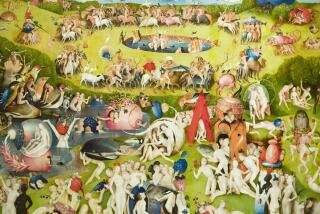FROM THE BRINK OF EXTINCTION
- Share via
There is something uncommonly melancholy about the pictures of the last wild condor being captured for his own good. What you have is civilization trying to forestall the consequences of civilization.
Having encroached on their terrain with weaponry, housing tracts and backpacks, we have left the condors a little too distracted by the stresses of keeping fed and sheltered to tend to their breeding properly.
The thought, possibly, is that captivity the condors will be too bored to do anything except breed. I hope they do breed. Ugly and evil-smelling scavengers need love, too. The extinction of any living species is somber commentary on what we have done with or to the natural world.
I hope the naturalists can save the birds, although after years of three squares a day and thousands of eyes gazing into their aviaries, the condors young and old may well lose their survival skills. Whether any of them will be able to fly free again in the wilderness is a question, and I’m sure it’s a question that bothers the counter-thinkers who are against the captive breeding program.
It may also be that condors are as self-conscious as other species are about doing their breeding in public, and that the project may be doomed by an understandable niceness of feeling in the birds. A darker thought is that condors after all their millennia together have simply grown weary of the sight of each other, and are only turned on by trimmer models, like hawks.
A friend of mine is monitoring a project in Wyoming, where naturalists are hoping to encourage the endangered black-footed ferrets to replenish themselves. The ferrets’ problem is that their chief food source is the prairie dog, and the prairie dogs’ vast subterranean tunnel villages are being squeezed, like the condors’ mountain vastnesses, by the onrush of civilization.
It is significant that preservation has become a hot word in almost every corner of civilization, from the arms limitation talks which, with any kind of persistence and ingenuity, may possibly save civilization as a whole, to the protection of untidy birds and small mammals and the capturing of fading sounds and dying arts.
The prospect of hanging, as a condemned man was said to have said, concentrates the mind wonderfully. There is nothing like the prospect of extinction to sharpen your appreciation for what was, what is and what may shortly not be.
The blessing of post-Edison recording devices, from film to LPs, is that at least we’ll know what we’ve lost. But, on the upside, there is plenty of evidence, for example, that the pioneer searchers after folk songs, folk playing and folk poetry have passed along a rich legacy for later generations to keep alive and expand on.
Country fiddling has always been a hand-me-down art, the youngsters learning the old tunes from the old-timers, with hardly a scrap of written music in sight. The Montana Arts Council has thoughtfully funded a Montana Folklife Project, and one of the project’s undertakings has been to record some of the state’s fiddlers, men and women.
The project has now produced an album of the music, called “If You Can’t Dance to It, It’s Not Old-Time Fiddle!” It is as lively as the title but there is also a thoughtful brochure by Michael Korn, who runs the Montana Folklife Project, and Jo Rainbolt and Glenda Bradshaw, and an extensive bibliography.
The styles are remarkably varied, from the roughest, self-taught hoedown sawing to some smoothly syncopated contemporary Western playing. Norwegian-born Anund Roheim plays a special violin named for Hardanger, Norway, with a second set of strings that pick up resonances from the main strings and provide a shimmering underscore.
Alec Allery plays a French-Canadian style called “Metis,” which includes a metronomic foot-tapping the fiddlers call “kicking.”
Four of the fiddlers on the album have died since the recordings were made; others are in their 80s. Time is the folklorist’s prime adversary.
Korn, an anthropologist who grew up in the San Fernando Valley, has also produced with Jo Rainbolt an album of cowboy poetry and songs called “When the Work’s All Done This Fall” and featuring some of the classic Western items. The mournful title song is sung by Earsel Bloxham and that wry tribute to the unbreakable bronc, “The Strawberry Roan,” is sung by Val Giessler, one of the best known of current Montana troubadours.
As Korn notes on the album cover, support for the Folklife Project comes from the state’s Coal Severance Tax funds. “In this way the product of one non-renewable resource supports another.”
The project is at a magnificently Montanan address, 35 S. Last Chance Gulch, Helena, Mont. 59620, and the albums are $9.45 including postage.
The music and the poetry live; we can wish as much for the condor.
More to Read
Sign up for Essential California
The most important California stories and recommendations in your inbox every morning.
You may occasionally receive promotional content from the Los Angeles Times.













